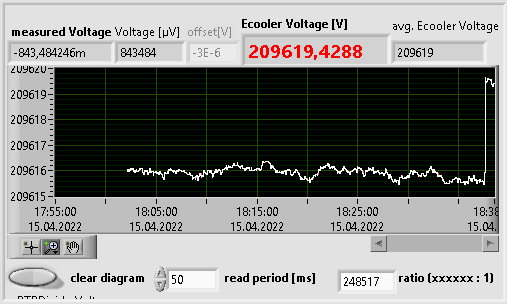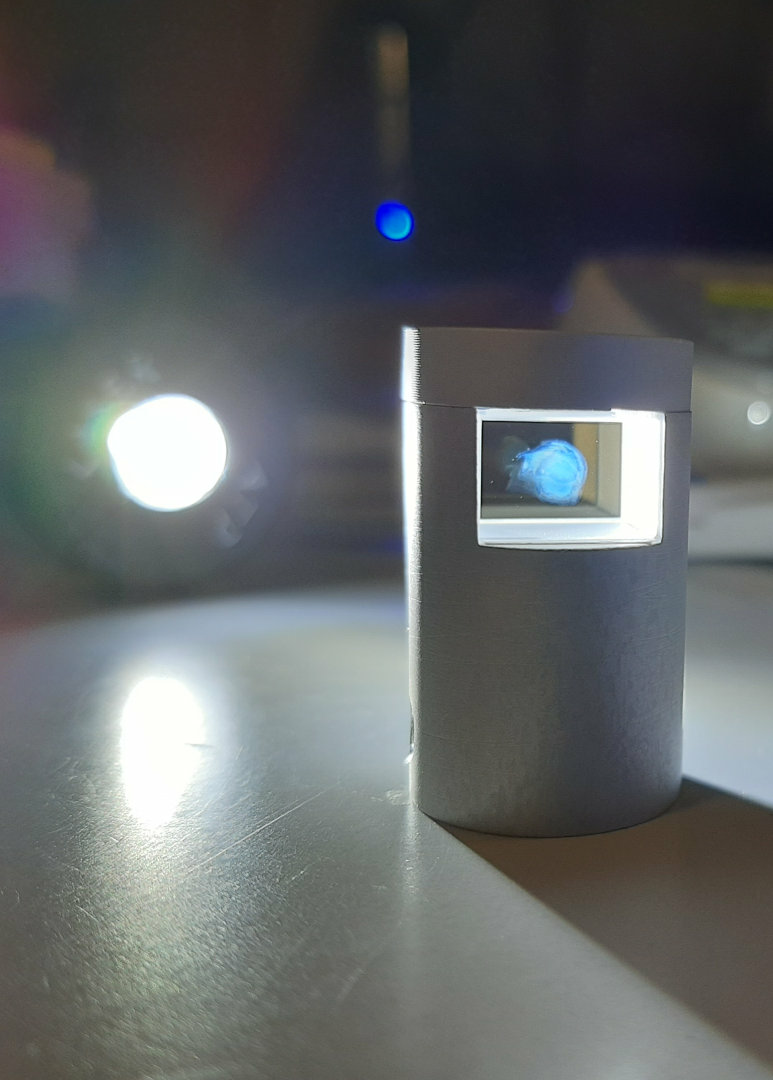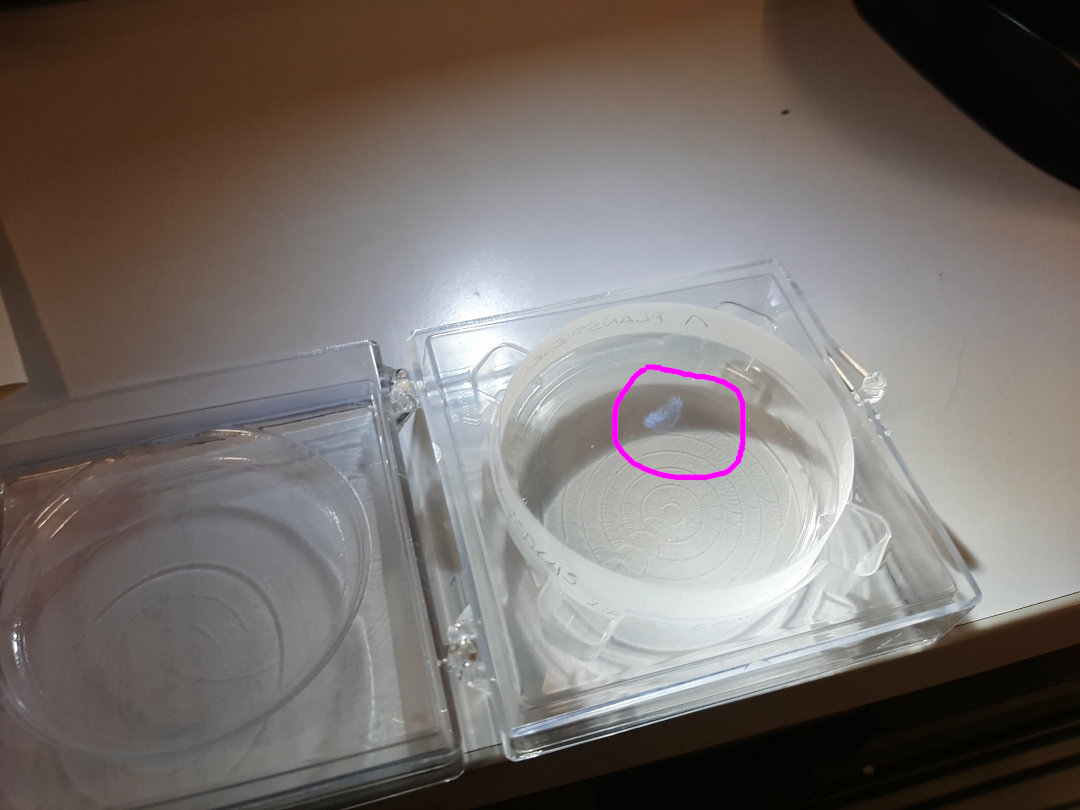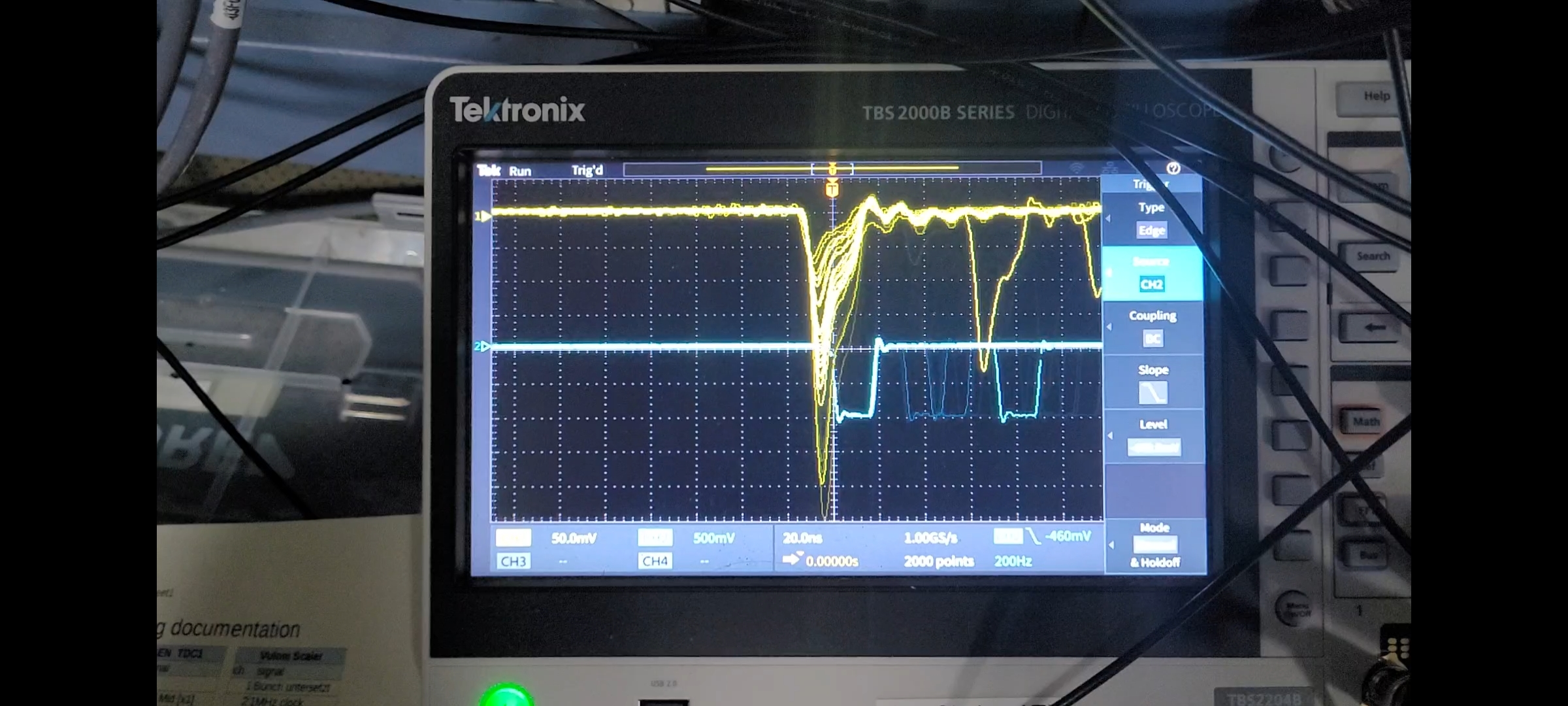| ID |
Date |
Author |
Category |
Subject |
|
226
|
Thu Apr 14 08:41:42 2022 |
Carsten | Accelerator | Low intensity at the experiment after series of failures during the night |
After the recovery from the failures during the night, we see much lower intensity at the experiment (measured with the particle detector count rate).
Instead of 8000-10000 cts we see only 3000-4000cts at comparable SIS intensities.
Also ESR cooler seems to be slightly unstable (wiggling lines) during injection. However, it is visually evident from the Schottky that the injected intensity already is much lower than yesterday evening.
All devices in ESR are (seem to run ) runnng properly, and also slit position (PN devices) are ok.
I am going to open the slits iin the SIS ESR transfer beamline. It would be useful to check for the SIS-ESR timing. |
|
227
|
Thu Apr 14 10:57:11 2022 |
Carsten | Accelerator | Maintanence UNILAC / Op training |
We had no beam since about 1000. Also, we are still trying to find out why we have such a low intensity in the expereimnt.
Presently, there is a planned maintenance in the UNILAC, beam is expected back in 25-30 mins.
The profile grid TE3 in the transfer beamline in front of the target will be used to check if the extracted SIS beam has changed compared to before the crash of the SIS.
All devices in the ESR seem to work normally including ramping of cooler current/voltage, dipole correction windings and sextupoles (all checked).
As we observed that coolng performace after injection is much worse Markus (Steck) suggested that we could try a longer manual cooling in machine 3 (pleae no cahnges in timimng) to see whether the SIS energy has changed (similar to about 1 week ago).
Cooler elctron current iis put back to 450ma (inejection / 40mA measurement). |
|
228
|
Thu Apr 14 12:27:18 2022 |
Sebastian, Max | Detectors | Connection to XUV / Cu reestablished! |
The connection to the XUV and Cu were lost during the nightshift.
The XUV detector was in the park position,
BUT the Cu mirror was in the "Measurement position" (moved in / active).
This could be one of the main problems that we had much lesser ion beam intensity since the UNILAC and SIS18 failures last night. |
|
229
|
Thu Apr 14 12:38:38 2022 |
Sebastian | Detectors | XUV / Cu checkups |
Check regularly if the connection to the XUV and Cu detectors are still active and the detectors move in (after injection) and out (after killing the ion beam).
Therefore, 2 programs should run on the computer where you can also see the running Schottky.
One of the programs is for the XUV and one is for the Cu mirror.
There the Automisation button should be activated!!!
ID 30 contains the manual how to run / start and operate both detectors. |
|
230
|
Thu Apr 14 17:47:55 2022 |
Carsten, Rodolfo, Konstantin, Sarper | Runs | Afternoon shift runs 14.04 changing the wavelength scan range |
The new scan range is changed from 321.12 - 320.60 nm to 320.62 - 320.10 nm
|
Time | SIS-intensity | cooler-HV | LMD-DAQ2 file nr | LMD-DAQ1 file nr | scan range(nm) | step width(nm) | dwell time(s) | particles counted | comments
| |
18:36 | 9.5e8 | 209618 | 0301 | 8014 | 320.62 - 320.10 | 0.002 | 5s | 6270 |
| |
19:45 | 9.4e8 | 209615 | 0302 | 8015 | 320.62 - 320.10 | 0.002 | 5s | 5400 |
| |
20:44 | 8.4e8 | 209618 | 0303 | 8016 | 320.62 - 320.10 | 0.002 | 5s | 4210 |
| |
21:37 | 8.9e8 | 209616 | 0304 | 8017 | 320.62 - 320.10 | 0.002 | 5s | 4550 |
|
|
|
231
|
Thu Apr 14 19:46:46 2022 |
Sarper & Konstantin & Rodolfo | Laser | Laser power |
We checked the laser power before starting the new scan range.
- Seed energy before Cobra @ 532 nm: 513 mJ (before 499 mJ).
- New correction factor for Monitor: 71.25.
- UV output energy after SHG @ 320.1 nm: 11 mJ
All values are averaged over 500 laser pulses. |
|
232
|
Thu Apr 14 22:44:40 2022 |
Patrick, Simon, Danyal, Max | Runs | Runs night shift 14./15.04. |
Runs of the night shift. The wavelength range is 320.62 - 320.10 nm.
|
Time | SIS-intensity | cooler-HV | LMD-DAQ2 file nr | LMD-DAQ1 file nr | scan range(nm) | step width(nm) | dwell time(s) | particles counted | comments
| |
22:38 | 9.5e8 | 209621 | 0305 | 8018 | 320.62 - 320.10 | 0.002 | 5s | 5000 | laser scan was started 1 min late
| |
23:38 | 9.8e8 | 209622 | 0306 | 8019 | 320.62 - 320.10 | 0.002 | 5s | 5550 |
| |
00:32 | 1.0e9 | 209621 | 0307 | 8020 | 320.62 - 320.10 | 0.002 | 5s | 4000 | After ~4000 counted particles (second scan, 1:04 am) the e-cooler went off.
| |
01:21 | 1.1e9 | 209622 | 0308 | 8021 | 320.62 - 320.10 | 0.002 | 5s | 6700 |
| |
02:12 | 1.2e9 | 209623 | 0309 | 8022 | 320.62 - 320.10 | 0.002 | 5s | 6400 |
| |
03:03 | 1.1e9 | 209624 | 0310 | 8023 | 320.62 - 320.10 | 0.002 | 5s | 5500 |
| |
03:55 | 1.3e9 | 209622 | 0311 | 8024 | 320.62 - 320.10 | 0.002 | 5s | 7700 |
| |
04:47 | 1.2e9 | 209622 | 0312 | 8025 | 320.62 - 320.10 | 0.002 | 5s | 5300 |
| |
05:36 | 1.2e9 | 209620 | 0313 | 8026 | 320.62 - 320.10 | 0.002 | 5s | 6666 |
| |
06:25 | 1.2e9 | 209619 | 0314 | 8027 | 320.62 - 320.10 | 0.002 | 5s | 6500 | change of shift crew (Danyal & Max)
| |
07:16 | 1.2e9 | 209618 | 0315 | 8028 | 320.62 - 320.10 | 0.002 | 5s | 5230 |
| |
08:13 | 1.2e9 | 209620 | 0316 | 8029 | 320.62 - 320.10 | 0.002 | 5s | 6600 |
| |
09:04 | 1.1e9 | 209619 | 0317 | 8030 | 320.62 - 320.10 | 0.002 | 5s | 6660 |
| |
09:54 | 1.2e9 | 209619 | 0318 | 8031 | 320.62 - 320.10 | 0.002 | 5s | 5950 |
| |
10:49 | 1.1e9 | 209619 | 0319 | 8032 | 320.62 - 320.10 | 0.002 | 5s | 6580 |
| |
11:38 | 1.1e9 | 209617 | 0320 | 8033 | 320.62 - 320.10 | 0.002 | 5s | 5380 |
| |
|
|
|
233
|
Fri Apr 15 12:42:18 2022 |
Max, Danyal, Carsten, Konstantin, Patrick, Simon | General | laser wavelength range changed: 320.12 - 319.60 nm |
Runs of the morning/afternoon/night shift. The wavelength range is now 320.12 - 319.60 nm.
|
Time | SIS-intensity | cooler-HV | LMD-DAQ2 file nr | LMD-DAQ1 file nr | scan range(nm) | step width(nm) | dwell time(s) | particles counted | comments
| |
12:51 | 1.2e9 | 209617 | 0321 | 8034 | 320.12 - 319.60 | 0.002 | 5s | 5530 | ERS Trafo 1.25e7 --> 1.2e9
| |
13:43 | 1.2e9 | 209617 | 0322 | 8035 | 320.12 - 319.60 | 0.002 | 5s | 6408 | at 13:49 there was a short broadening of the ion beam in the Schottky spectrum
| |
14:35 | 1.16e9 | 209618 | 0323 | 8036 | 320.12 - 319.60 | 0.002 | 5s | 6585 |
| |
15:30 | 1.08e9 | 209617 | 0324 | 8037 | 320.12 - 319.60 | 0.002 | 5s | 5701 |
| |
16:20 | 1.10e9 | 209617 | 0325 | 8038 | 320.12 - 319.60 | 0.002 | 5s | 5470 |
| |
17:11 | 1.11e9 | 209617 | 0326 | 8039 | 320.12 - 319.60 | 0.002 | 5s | 5519 |
| |
18:00 | 1.08e9 | 209616 | 0327 | 8040 | 320.12 - 319.60 | 0.002 | 5s | 5402 | Ecooler voltage suddenly jumped to 109619 around 18:30. Laser spot seems to drift slowly to an inner position (left on the screen). This might be due to an interplay between a decreasing laser power and the position sensitive detectors of the beam stabilization.
| |
18:52 | 1.16e9 | 209620 | 0328 | 8041 | 320.12 - 319.60 | 0.002 | 5s | 6948 |
| |
20:39 | 1.13e9 | 209619 | 0329 | 8042 | 320.12 - 319.60 | 0.002 | 5s | 6xxx | Dye was changed before this run was started
| |
20:32 | 1.20e9 | 209620 | 0330 | 8043 | 320.12 - 319.60 | 0.002 | 5s | 6948 |
| |
22:25 | 1.21e9 | 209619 | 0331 | 8044 | 320.12 - 319.60 | 0.002 | 5s | 7120 | Night shift took over (Patrick, Simon)
| |
23:15 | 1.26e9 | 209619 | 0332 | 8045 | 320.12 - 319.60 | 0.002 | 5s | 7080 |
| |
00:06 | 1.25e9 | 209616 | 0333 | 8046 | 320.12 - 319.60 | 0.002 | 5s | 6500 |
| |
00:59 | 1.23e9 | 209616 | 0334 | 8047 | 320.12 - 319.60 | 0.002 | 5s | 5380 |
| |
01:50 | 1.30e9 | 209616 | 0335 | 8048 | 320.12 - 319.60 | 0.002 | 5s | 6750 |
| |
02:41 | 1.38e9 | 209616 | 0336 | 8049 | 320.12 - 319.60 | 0.002 | 5s | 6970 |
| |
03:32 | 1.37e9 | 209616 | 0337 | 8050 | 320.12 - 319.60 | 0.002 | 5s | 7010 |
|
|
| Attachment 1: VoltageJump1830.PNG
|

|
|
234
|
Fri Apr 15 12:53:25 2022 |
Max, Danyal | Laser | checked laser pulse energy after change in wavelength range |
previous scan range:
the laser pulse energy @ 320.62 nm was ~11 mJ
new scan range:
the laser pulse energy @ 320.12 nm was ~11 mJ
the laser pulse energy @ 319.60 nm was ~10 mJ |
|
235
|
Fri Apr 15 20:43:18 2022 |
Konstantin | Laser | Dye changed |
Dye of the laser system has been changed. UV laser power increased from ~8 mJ to 11 mJ pulse energy. |
|
236
|
Sat Apr 16 04:19:05 2022 |
Patrick, Simon, Alex, Sarper | Runs | Runs night + morning shifts 16.04. |
Runs of the night shift 16.04. after changing the wavelength range. The new range is 320.12 - 319.859 nm. The step size was decreased from 0.002 nm to 0.001 nm.
The goal was to have the same number of scans as before (261), however, the scan range in the labview program could not be set accordingly. We decided to go with 262 scans after the first run.
|
Time | SIS-intensity | cooler-HV | LMD-DAQ2 file nr | LMD-DAQ1 file nr | scan range(nm) | step width(nm) | dwell time(s) | particles counted | comments
| |
04:24 | 1.28e9 | 209616 | 0338 | 8051 | 320.12 - 319.86 | 0.001 | 5s | 6750 | This run had only 260 scans
| |
05:18 | 1.20e9 | 209615 | 0339 | 8052 | 320.12 - 319.859 | 0.001 | 5s | 6300 | First run with 262 scans
| |
06:09 | 1.36e9 | 209615 | 0340 | 8053 | 320.12 - 319.859 | 0.001 | 5s | 6910 | laser scan started 2 min late at 650 counts
| |
07:03 | 1.24e9 | 209615 | 0341 | 8054 | 320.12 - 319.859 | 0.001 | 5s | 6330 |
| |
07:59 | 1.23e9 | 209615 | 0342 | 8055 | 320.12 - 319.859 | 0.001 | 5s | 5712 |
| |
08:51 | 1.1e9 | 209615 | 0343 | 8056 | 320.12 - 319.859 | 0.001 | 5s | 4380 |
| |
09:44 | 1.28e9 | 209615 | 0344 | 8057 | 320.12 - 319.859 | 0.001 | 5s | 5135 |
| |
10:39 | 1.25e9 | 209615 | 0345 | 8058 | 320.12 - 319.859 | 0.001 | 5s | 5860 |
| |
11:30 | 1.2e9 | 209615 | 0346 | 8059 | 320.12 - 319.859 | 0.001 | 5s | 6500 |
| |
12:22 | 1.23e9 | 209618 | 0347 | 8060 | 322.41 - 322.00 | 0.002 | 5s | 5200 | Laser wavelength scan range is changed to 322.41 - 322.00 nm and increment to 0.002 nm.
| |
13:04 | 1.2e9 | 209616 | 0348 | 8061 | 322.41 - 322.00 | 0.002 | 5s | 4411 |
| |
13:50 | 1.2e9 | 209616 | 0349-0351 | 8062-8063 | 322.41 - 322.00 | 0.002 | 5s | 10651 | last scan / 10 loops ~ 3 hours of scan -- Ecooler failed, realized at 16:05 we were on loop8, laser is turned off at 16:10
|
|
|
237
|
Wed Apr 20 10:09:50 2022 |
Rodolfo | Laser | Optic with spots |
| The average energy produced by the laser along the beamtime was about 10 mJ/puls. After about two weeks of beamtime some of the optics, especially the optic placed just after the BBO crystall, got some spots, see pictures below. Here the diameter of the laser beam is about 6 mm. |
| Attachment 1: SHG_Compensator_mitFleck_19-04-2022.jpg
|

|
| Attachment 2: UV_Umlenkspiegel_mitFleck_19-04-2022.jpg
|

|
|
84
|
Tue Mar 25 06:22:10 110 |
Ken Ueberholz | Detectors | XUV-Detector Rates |
Count rates were measured for the XUV-
detector for a full circle:
Cathode: -5V, shields: 0V, main coil 8A,
sec coil 2A,
No beam - pos 0mm: ~10 Hz
Hot beam - pos 0mm: ~5 kHZ
Cool beam - pos 147mm: ~200Hz |
| Attachment 1: Screenshot_20220404-000343_Gallery.jpg
|

|
| Attachment 2: Screenshot_20220404-000327_Gallery.jpg
|

|
| Attachment 3: Screenshot_20220404-000411_Gallery.jpg
|

|